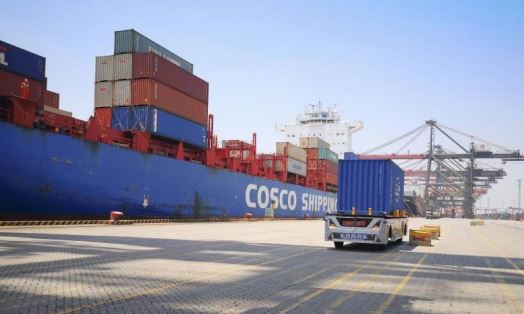In the morning of May 11, an automated driverless truck for containers delivered the containers for loading the Vessel COSCO SHIPPING ROSE next to the shore bridge No. 102 and collected containers unloaded from the vessel under the shore bridge No. 101. Driving all the way from the front of the wharf
to Jingyi Road, it automatically avoided obstacles on the road to enter the F1 yard, and completed a series of operations such as accurate positioning with the tire crane and unloading in the yard, smoothly completing the shiploading and unloading operation processes.
This marked that the first customised platform port jointly developed by COSCO SHIPPING Ports Limited, Dongfeng Commercial Vehicle Co., Ltd. and China Mobile (Shanghai) Information Communication Technology Co., Ltd. for driverless container truck has passed the trial run for actual production and operation, adding another constructive result to the construction of 5G smart ports!
China COSCO SHIPPING Corporation Limited, China Mobile Communications Group Co., Ltd. and Dongfeng Motor Corporation jointly held the “5G+ Driverless-enabled Smart Ports” Online Conference in six cities,
namely Beijing, Shanghai, Wuhan, Shiyan, Hong Kong and Xiamen, through China Mobile 5G+ online video conference system, witnessing the on site operation of driverless container trucks for ports.
Zhuang Jiahan, Deputy Secretary of Xiamen Municipal Party Committee and Mayor of Xiamen, Xu Lirong, Chairman of COSCO SHIPPING, Yang Jie, Chairman of China Mobile, and Zhu Yanfeng, Chairman of Dongfeng Corporation attended the conference and together witnessed the entering of implementation stage of the 5G smart port in Xiamen Ocean Gate Terminal from the experimental stage.
COSCO SHIPPING Ports, COSCO SHIPPING Technology Co., Ltd and China Mobile (Shanghai) ICT jointly issued the Implementation Plan And Roadmap For 5G Smart Ports, which set out the definition and vision of 5G smart port construction, stipulated the general structure of the smart port as well as implemented the typical applications of 5G smart ports in stages.
By 2025, the coastal container hub ports aim to initially establish an intelligent system with comprehensive perception, ubiquitous interconnection, and port-vehicle collaboration, as proposed in the Guiding Opinions on Building Word-class Ports.
COSCO SHIPPING Ports, COSCO SHIPPING Technology, Xiamen Ocean Gate Container Terminal Co., Ltd., China Mobile (Shanghai) ICT, China Mobile Group Fujian Company Limited Dongfeng Commercial Vehicle, Huawei Technologies Co., Ltd., Shanghai Zhenhua Heavy Industries Co.,
Ltd., and Shenzhen Yuanrong Qixing Technology Co., Ltd. jointly released the “White Paper on All Business Scenarios of the 5G Smart Ports Implementation”, in which the industry partners have, with reference to the current situation of Xiamen Ocean Gate Terminal, built business scenarios of 5G smart port implementation based on the construction of 5G private network in the port area that combined with technologies such as edge computing, high-precision positioning, artificial intelligence and computer
vision. The successful practice of the model project undertaken at Xiamen Ocean Gate Terminal has fully demonstrated that 5G technology would inject new vitality to the development of port automation, digitisation and informatisation, and promote the intelligent upgrade and transformation of ports.
COSCO SHIPPING Ports, Dongfeng Commercial Vehicle and China Mobile (Shanghai) ICT jointly issued the joint enterprise standard of Performance And Test Methods For Driverless Truck For Containers In The Ports, which is the first standard of performance and test methods for driverless truck
for containers in the ports. The joint enterprise standard is divided into four sections, namely: driving scene and driving behavior requirements, wireless communication and information security requirements, vehicle function and performance technical requirements, vehicle testing and test methods. Each section contains scope of application of the standard, normal reference documents, terms and definitions of the standard and the specific technical performance requirements. Such standard is applicable to the development process of the intelligent network-connected automated system for driverless truck for containers in the ports, and has been approved by the Ministry of Communications and C-ITS Intelligent Transportation Industry Alliance for documentation.
COSCO SHIPPING Ports, Dongfeng Commercial Vehicle and China Mobile (Shanghai) ICT signed a Letter of Intent for extending application at 5G+ smart port. The three parties of the cooperation actively responded to the development strategy of “National strength in transportation” by expanding “smart+” to enable the transformation and upgrading of the manufacturing industry, which further promoted the indepth integration of 5G technology and the construction of smart ports.
The research results presented at this conference provided an implementation plan for domestic and international 5G smart ports, which was a concrete action to accelerate the implementation of the “Broadband China” and “National strength in transportation” strategies and to promote the construction of new infrastructure. Especially with global efforts and measures to control the Coronavirus, it is important to promote industrial innovation through 5G and support the ports to fight against the Coronavirus, which is of practical significance and can serve as a reference to promote the resumption
of work and manufacturing.
























